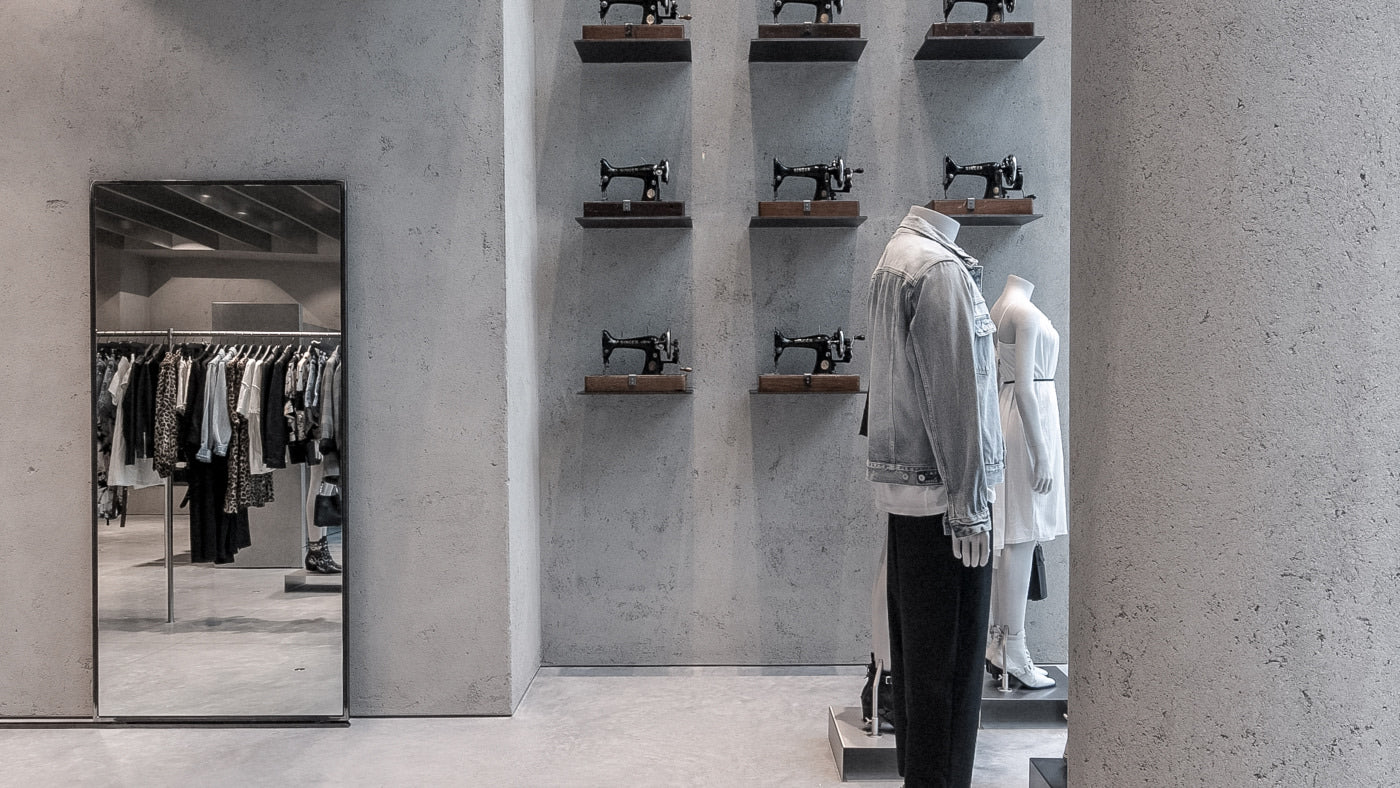
skinflint meets: Clayworks
Clayworks' ecological concrete-effect surfaces at AllSaints Manchester (above). Credit: Taran Wilkhu
From humble beginnings building earth cob houses, Clayworks' founders Adam Weismann and Katy Bryce have nurtured their passion for natural and sustainable construction to create their business as it’s known today - manufacturing unique blends of natural clay plaster for architectural and interior design practices around the world. They tell us more in our next installment of skinflint meets:
 Our industrial XL Hungarian pendant light in Clayworks' showroom, above and below. Credit: Edmund Sumner
Our industrial XL Hungarian pendant light in Clayworks' showroom, above and below. Credit: Edmund Sumner
skinflint: Tell us about how Clayworks came about...
Clayworks: Clayworks was born from a love and belief in natural, sustainable building materials, which grew out of our deep affection for nature itself. Katy and I did an apprenticeship in building with earth (cob) in Oregon which began our journey working with these materials. We then spent a decade restoring old buildings, building new ones and travelling the world to learn about the traditions of clay as a building material. The fascination - perhaps obsession - with the beauty, performance and aesthetic qualities of clay grew. We saw the beauty of natural materials to affect the way we experience the spaces we inhabit and to help provide the most intelligent solutions possible in a construction industry that is not concerned with ecological destruction.
Researching for our two books ‘Building with Cob’ and ‘Clay and Lime Finishes’ gave us the opportunity to study and learn from master plasterers/traditions around the world. We established Cob in Cornwall in 2002 and built cob structures, finishing their interior walls with clay dug up on site. In 2008 we decided to focus on creating ready-made clay plasters that would be consistent in their quality and performance and that could be readily available. After two years of intense research, both in the field and in laboratories, we launched our own clay plasters in 2010 and re-named the company Clayworks.

At skinflint we’re all about salvaging, restoring, recycling and reusing products that would’ve otherwise become obsolete. In what ways is Clayworks changing the way we think about design and interiors?
Like skinflint, we appreciate the capacity of design and craftsmanship to positively affect the way we experience materials. Clay plasters are made from naturally abundant earthen materials that are not manufactured as such, simply blended with almost no processing. They remain as raw materials, even when on the walls as they do not change their state and are not fired during any stage of the process. We use no water during the blending process (only for cleaning) and because of the nature of the materials, there is no waste and no by-products. No synthetics or additives are added. At the end of their life, clay plasters are compostable. Consequently, huge carbon savings are made by using clay finishes.
Where do you draw inspiration from when creating different textured finishes?
We draw inspiration from vernacular architecture and interiors around the world and from throughout history. Our travels have taken us throughout America where we take particular stimulus from the construction techniques and finishes of Native Americans and also to places like Morocco and its spectacular array of internal and external finishes. Japanese interior finishes (often clay mixed with straw) and Japanese ceramics with their unique patinas have always deeply influenced our ideas, as has pottery from the South West. Leach pottery is certainly an inspiration.

Clayworks in Walmer Yard, London, designed by architect and academic Peter Salter. Credit: Edmund Sumner
Clayworks’ surfaces are found in some incredible retail spaces... Alexander McQueen, Aesop and Paul Smith to mention just a few. Which projects are you particularly proud of and why?
Projects that are truly unique, that have led the Clayworks team to push really hard at the conventional boundaries of techniques with clay, are particularly special. The fading textures and ombre coloured plasters developed for the Mayfair Aesop store, the Rammed Earth Effect wall at Gentle Monster, London and the rock-like finishes in Sticks n Sushi restaurant. Working with Peter Salter on the Walmer Yard (above) project was interesting - they had us match the colour that they wanted to the colour of a cow! A culture of learning, discovery and experimentation continues every day and we have a range of finishes that look like the ever-popular concrete effect, but without the environmental and health toll.
 Clayworks Princess Project. Credit: Frederik Vercruysse
Clayworks Princess Project. Credit: Frederik Vercruysse
What are, in your opinion, the biggest challenges the industry faces?
Architecture must change: buildings must have a more gentle impact on the world/environment. The construction industry has become used to using materials that are not helpful for a sustainable world and are often not designed for optimal indoor comfort and human health. Clayworks is working hard, along with many other organisations, to show the architecture and design world that simple, natural materials such as clay, wood, straw are no longer eco-niche, but the sensible, viable and most beautiful materials of the future.
What has been your biggest achievement to date?
Spearheading a new way of thinking about sustainable building materials and repositioning clay plasters in the market have been fulfilling achievements, but this would not have been possible without our team. Building a great team of passionate, competent people, in our remote little corner of the world on the Lizard peninsula is what has made everything possible.
Tell us about the effect the interplay of light has on the different surfaces you produce...
The interplay of natural light on clay plasters is exhilarating. Clay simultaneously emanates a natural light, while absorbing glare. As a result, the colours and shadows are not only enhanced, but they change as the light changes through the day and the seasons and according to which way the surfaces are facing. The same finish in one room can look magically different, helping to create true architectural drama.
Finally, why did you pick these two particular vintage industrial pendant lights for your showroom?
We love the industrial heritage that runs through the design, the uniqueness of each light and the true sophistication of the design and craftsmanship.
 Vintage substation pendants by Benjamin (above)
Vintage substation pendants by Benjamin (above)
 XL Hungarian industrial lighting (above)
XL Hungarian industrial lighting (above)
Read more about our vintage lights in Clayworks' showroom here.
You might also like
Irish Examiner: Vintage View
Our vintage cut glass chandeliers have been included for their authentic 1970s nostalgia and vintage style.
In the pressWhy we won't be participating in Black Friday
Every November the chaos of Black Friday descends upon us causing needless over-consumption. This year we hope you’ll join us in making a stand, by buying nothing and repairing something instead. #GreenFriday
Sustainabilityskinflint Full Circle buy-back scheme makes the Evening Standard top 10
Drum roll please...our buy-back scheme Full Circle has been included in the Evening Standard’s 10 of the best interior buy-back and repair schemes alongside household names such as Ikea and John Lewis!
B Corp






